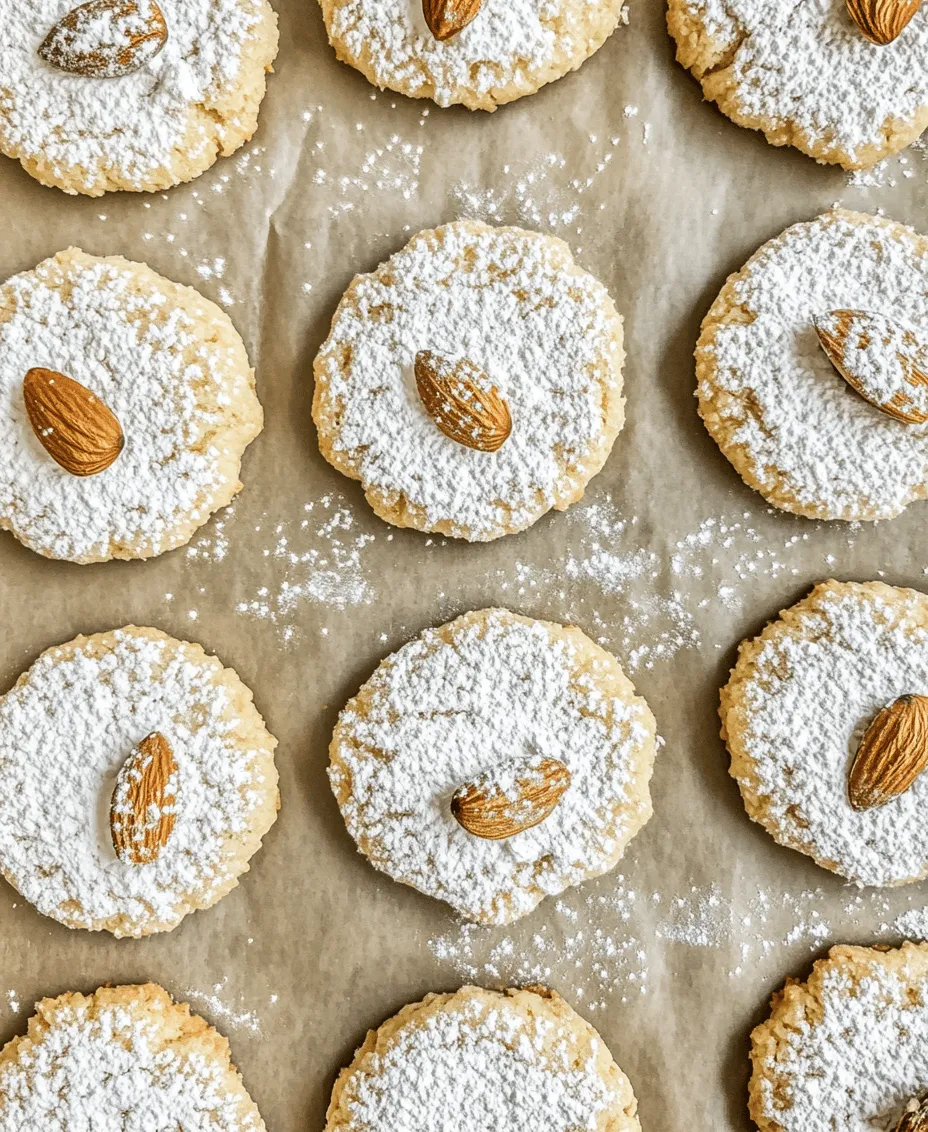Introduction
Greek Almond Cookies, known as Amygdalota, are delightful confections that capture the essence of Greek culinary tradition. These cookies are not only a treat for the taste buds but also a symbol of various cultural celebrations in Greece. Made primarily from almond flour, they boast a unique texture and rich flavor that delights anyone who tries them. If you’re seeking to explore the world of Greek desserts, Amygdalota offers a fascinating journey into both the history and the heart of Greek cuisine.
The cultural significance of almond cookies in Greece is profound. They are often prepared during special occasions such as weddings, religious festivals, and family gatherings, symbolizing love, unity, and celebration. As you embark on this baking adventure, you can expect to learn not only how to create these delicious cookies but also to appreciate their historical context and cultural importance.
In this article, we will delve into the origins of Amygdalota, explore the key ingredients that make this recipe unique, and provide you with a detailed step-by-step guide to successfully baking your own batch of these traditional Greek almond cookies.
Exploring the Origins of Amygdalota
The history of almond cookies in Greece dates back centuries, intertwining with the broader narrative of Mediterranean cuisine. Almonds have been cultivated in Greece since ancient times, valued not only for their delightful flavor but also for their nutritional benefits. In Greek culture, almonds symbolize prosperity and good fortune, often featured in various dishes and desserts.
Amygdalota is particularly prevalent in the regions of Chios and Naxos, where local variations showcase the creativity and resourcefulness of Greek bakers. Each region boasts its own unique take on these almond cookies, incorporating local ingredients and flavors that reflect their distinct culinary identities. For example, while some may prefer a more traditional approach with minimal additives, others might infuse their cookies with hints of citrus or spices, demonstrating the versatility of almond-based confections.
As you venture further into the realm of Amygdalota, you’ll discover that the preparation and presentation of these cookies can vary widely across Greece. In some areas, they may be rolled in powdered sugar or adorned with whole almonds, while in others, the cookies might feature a subtle hint of orange blossom water, adding a fragrant note that elevates their overall appeal. This diversity not only highlights regional tastes but also celebrates the enduring legacy of almond cookies in Greek culture.
Ingredients Breakdown
To create the perfect Greek Almond Cookies, you’ll need a few key ingredients that contribute to their signature texture and flavor. Let’s break down these essential components:
1. Almond Flour: The heart of Amygdalota, almond flour provides the cookies with a rich, nutty flavor and a delicate crumb. Unlike traditional wheat flour, almond flour is gluten-free, making these cookies a suitable option for those with gluten sensitivities. This unique ingredient is what gives the cookies their characteristic moistness and chewiness.
2. Granulated and Powdered Sugar: Sweetness is a defining aspect of any cookie, and Amygdalota is no exception. Granulated sugar helps to create a balanced sweetness, while powdered sugar is often used for dusting the finished cookies, offering a visually appealing contrast and an extra touch of sweetness. Achieving the right balance between these sugars is crucial for the overall flavor profile of the cookies.
3. Egg Whites: As a binding agent, egg whites play a vital role in the structure of the cookies. They help to hold the ingredients together while also contributing to the light and airy texture that is characteristic of Amygdalota. The use of egg whites instead of whole eggs results in a less dense cookie, allowing the almond flavor to shine through.
4. Vanilla Extract and Orange Blossom Water: These flavorings add depth and complexity to the cookies. Vanilla extract is a classic addition that enhances the overall sweetness, while orange blossom water imparts a subtle floral note that complements the almonds beautifully. Both ingredients work together to create a harmonious flavor profile that is quintessentially Greek.
5. Whole Almonds: For decoration, whole almonds are often placed on top of each cookie before baking. Not only do they add an appealing visual element, but they also enhance the nutty flavor and provide a satisfying crunch in contrast to the soft cookie texture. In Greek culture, whole almonds also symbolize fertility and prosperity, making them a fitting choice for festive occasions.
Step-by-Step Guide to Making Greek Almond Cookies
Now that you’re familiar with the origins and ingredients of Amygdalota, let’s dive into the exciting part: the preparation! Following these detailed instructions will ensure your cookies turn out perfectly every time.
Step 1: Preheat the Oven
Begin by preheating your oven to 350°F (175°C). This step is crucial, as it ensures that the cookies bake evenly and achieve the desired texture. While the oven heats up, you can prepare the baking sheets.
Step 2: Prepare Baking Sheets
Line two baking sheets with parchment paper. This will prevent the cookies from sticking and make for easy cleanup. If you don’t have parchment paper, you can lightly grease the baking sheets with a bit of oil or butter.
Step 3: Combine Dry Ingredients
In a large mixing bowl, combine your almond flour, granulated sugar, and a pinch of salt. Use a whisk to ensure that all the dry ingredients are well blended. This step is important for achieving an even distribution of flavors throughout the dough.
Step 4: Whip Egg Whites
In a separate bowl, whip the egg whites until they form soft peaks. This can be done using a hand mixer or a stand mixer. The fluffy texture of the whipped egg whites is essential for creating the light and airy quality of the cookies. Be careful not to over-whip, as this can lead to a dry mixture.
Step 5: Mix in Flavorings
Once the egg whites are ready, gently fold in the vanilla extract and orange blossom water into the whipped egg whites. This will incorporate the flavors into the mixture without deflating the egg whites.
Step 6: Combine Wet and Dry Ingredients
Add the whipped egg white mixture to the bowl of dry ingredients and fold gently until well combined. The dough should be slightly sticky but still hold its shape. If it’s too wet, you can add a bit more almond flour; if it’s too dry, a small amount of water can help moisten it.
Step 7: Shape the Cookies
Using your hands, take small portions of the dough and roll them into balls, about the size of a tablespoon. Place the balls onto the prepared baking sheets, leaving space between each cookie to allow for spreading during baking. If desired, gently press a whole almond into the center of each cookie for decoration.
Step 8: Bake the Cookies
Place the baking sheets in the preheated oven and bake for approximately 15-20 minutes, or until the cookies are lightly golden on the bottom but still soft to the touch. Keep an eye on them as baking times can vary based on your oven and the size of the cookies.
Final Steps (To Follow)
Once baked, allow the cookies to cool on the baking sheets for a few minutes before transferring them to a wire rack to cool completely. This cooling time helps the cookies firm up and enhances their texture.
As you prepare to enjoy your homemade Amygdalota, remember that these cookies not only embody the flavors of Greece but also tell the story of a rich and vibrant culinary tradition. Whether served at a special occasion or simply enjoyed with a cup of coffee, Greek Almond Cookies are sure to leave a lasting impression.

Mixing Dry and Wet Ingredients for the Best Dough Consistency
To achieve the perfect consistency for your Greek Almond Cookies, known as Amygdalota, it is crucial to properly mix both the dry and wet ingredients. Start by sifting together your dry ingredients—almond flour, sugar, and a pinch of salt—into a large mixing bowl. This step not only helps to aerate the flour but also ensures that the sugar is evenly distributed, which is essential for achieving a consistent texture.
In a separate bowl, combine your wet ingredients, which typically include egg whites, orange blossom water, and any other flavoring agents you choose to include. Gently beat the egg whites until they are frothy but not stiff, as this will help incorporate air into the mixture, enhancing the cookies’ lightness.
Now, it’s time to bring the two mixtures together. Gradually add the wet mixture to the dry ingredients, stirring with a spatula or wooden spoon. Be careful not to over-mix; you want to combine the ingredients until they are just incorporated. The dough should be slightly sticky but manageable. If it feels too dry, a few drops of additional orange blossom water can help achieve the desired consistency. This careful approach to mixing ensures that your cookies will have a soft, tender crumb once baked.
Tips for Shaping Cookies and Achieving the Perfect Size
Shaping your Amygdalota cookies is an important step in the process, as it affects both the appearance and baking time. After mixing your dough, let it rest for about 10 minutes. This resting period allows the ingredients to meld together and the almond flour to hydrate, making it easier to handle.
To shape the cookies, use a small cookie scoop or your hands to form bite-sized balls, approximately 1 inch in diameter. Keep in mind that these cookies will not spread much during baking, so the shape you create will largely remain intact. For a decorative touch, you can gently press a whole almond into the center of each cookie before baking. This not only enhances the visual appeal but also adds an extra layer of flavor.
For uniformity, consider using a kitchen scale to measure out each portion of dough. This ensures that all cookies bake evenly, providing a consistent texture and appearance. Once shaped, arrange the cookies on a parchment-lined baking sheet, leaving enough space for air circulation between them.
Baking Time and Temperature Considerations for Optimal Results
Baking the Amygdalota cookies requires attention to temperature and timing to ensure they achieve the perfect texture. Preheat your oven to 350°F (175°C) and prepare your baking sheets with parchment paper to prevent sticking and ensure even baking.
Place the shaped cookies in the preheated oven and bake for about 15-20 minutes. Keep a close eye on them during the last few minutes of baking; you want the cookies to turn a light golden color without browning too much. The baking time can vary depending on your oven and the size of your cookies, so it’s wise to check for doneness at the lower end of the time range. The edges should be firm to the touch while the centers may still look slightly soft—they will continue to firm up as they cool.
Cooling Process and Its Importance for Texture
After removing the cookies from the oven, it’s essential to allow them to cool properly. Transfer the cookies to a wire rack after a few minutes on the baking sheet. This cooling process not only helps to prevent them from becoming soggy but also allows the texture to set. The cookies should have a soft, chewy interior with a slight crispness on the outside.
If you skip the cooling step and stack the cookies while they are still warm, moisture will accumulate and cause them to lose their delightful texture. Allow them to cool completely before storing or serving; this will ensure that each bite is as delightful as intended.
Flavor and Texture Profile of Amygdalota
When you take a bite of Amygdalota, you can expect a delightful flavor and texture experience. The cookies possess a soft, chewy interior that contrasts beautifully with a slightly crisp exterior. The almond flour contributes a rich nuttiness, while the sugar adds a delicate sweetness. One of the standout flavor notes is the floral hint from the addition of orange blossom water, which elevates the cookies and gives them their distinct character.
Incorporating whole almonds not only enhances the presentation but also provides a satisfying crunch. These almonds can be lightly toasted before use to amplify their flavor, resulting in a more complex and aromatic cookie. Each bite is a harmonious blend of textures and tastes that capture the essence of Greek baking traditions.
Serving Suggestions and Pairings
Amygdalota cookies are versatile and can be enjoyed on various occasions, from casual gatherings to festive celebrations. They make a wonderful addition to dessert tables, especially during holidays or family gatherings. Consider serving them alongside other traditional Greek sweets for a well-rounded dessert experience.
For an ideal pairing, serve your cookies with a cup of strong Greek coffee. The bold flavors of the coffee beautifully complement the delicate sweetness of the cookies, creating an indulgent treat. Alternatively, herbal teas like chamomile or mint can provide a refreshing contrast, enhancing the floral notes of the orange blossom water.
Presentation is key when serving Amygdalota. Consider arranging the cookies on a decorative platter, garnished with fresh herbs or edible flowers for an elegant touch. If you plan to gift these cookies, package them in a beautiful box or tin, adding a personal note or a sprig of dried lavender to convey the flavors of Greece.
Nutritional Information and Dietary Considerations
When it comes to nutritional benefits, almond flour is a star ingredient in Amygdalota cookies. It is rich in healthy fats, fiber, and protein, making these cookies a more nutritious option compared to those made with regular flour. Almonds are also known for their antioxidant properties, contributing to overall health.
If you have dietary restrictions, consider alternative ingredients to accommodate different needs. For a gluten-free version, almond flour is already a suitable choice, ensuring that everyone can enjoy these delightful cookies. You can also explore sugar alternatives like coconut sugar or stevia for a lower glycemic index option, keeping the flavor profile intact.
Portion sizes are important to consider as well. These cookies are rich and satisfying, so serving one or two with a beverage is often sufficient. This allows everyone to enjoy the flavors without overindulging.
Conclusion
Making Greek Almond Cookies, or Amygdalota, is not just about baking; it’s about embracing the joy of creating something steeped in rich cultural traditions. The soft, chewy texture combined with the floral notes of orange blossom water creates a delightful experience that transports you to the heart of Greece with every bite.
These cookies encapsulate the essence of Greek hospitality and sweetness, making them a lovely addition to any occasion. Whether you’re enjoying them with a cup of coffee, sharing them with loved ones, or gifting them to friends, Amygdalota cookies are a testament to the beauty of Greek desserts.
As you explore the world of Greek baking, let the flavors and traditions inspire you, encouraging a deeper appreciation for the culinary arts. Enjoy the process, and savor every delicious moment you create.



